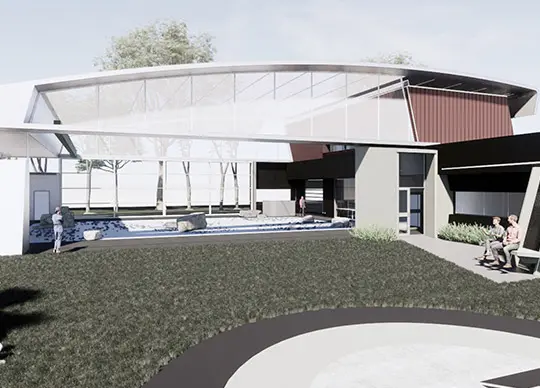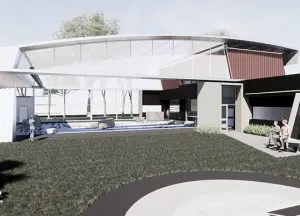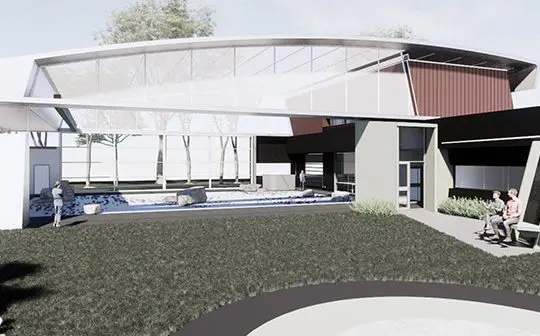

Image: A render of the QUT lunar testbed within the proposed space facility at Kelvin Grove campus. QUT/RAL Architects.
Queensland University of Technology (QUT) has received $1.2 million in new ARC funding and a green light to build Australia’s largest covered outdoor facility for testing equipment, robotics and materials processing techniques in realistic Moon, Mars, and asteroid conditions.
The 20 x 10 m lunar testbed will be capable of simulating different planetary environments to support robotics, sensing and other research applied to space.
The lunar testbed will be the first of its kind in Australia and will provide unique capabilities within QUT’s new $5 million space technology precinct to be opened in 2022 at the Kelvin Grove campus.
Leading development, Associate Professor Thierry Peynot from the QUT Centre for Robotics said autonomous rover navigation, materials instrumentation, simple construction and mining activities were among immediate applications.
“The QUT lunar testbed will allow researchers and partners to safely test operating rovers in the presence of airborne dust and is expected to support the development of a lunar rover for launch by 2026 as part of Australia’s first moon mission,” he said.
The lunar testbed will contain high-fidelity simulated regolith – fabricated moondust – slopes and boulders, a gantry crane for micro-gravity simulation, realistic lighting conditions, and high ceilings to facilitate tests between collaborative airborne and ground technologies.
QUT will relocate a dedicated research engineering support team to the facility, which includes office spaces and an onsite workshop. The facility is expected to expand practical learning opportunities for electrical engineering, robotics, mechatronics and industrial design students.
Community visitors will also be encouraged to observe rover and other simulations from a public viewing platform as part of QUT’s commitment to STEM outreach.
QUT secured funding for its lunar testbed from the Australian Research Council (ARC) Linkage Infrastructure, Equipment and Facilities (LIEF) scheme in December as part of a successful $2.1 million bid with UNSW to establish the Space Resources Environmental Analogue Facility (SREAF).
The SREAF will include QUT’s covered outdoor lunar testbed, and UNSW facilities including a smaller indoor testbed and dirty thermal vacuum chamber (DTVAC) for testing in temperature and pressure conditions expected in other planetary environments.
Professor Peynot said rover and other space technologies proved in the new facilities could qualify to operate on the Moon, for example, enabling participation in the Australian Space Agency’s Moon to Mars programs.
“Overall, facilities will be used to test robotics, sensing, geology, rock mechanics, materials, and space-related technologies in inhospitable environments. The lunar environment, for example, is incredibly challenging. It has no atmosphere; very fine, charged, and reactive dust that sticks to everything; 300-degree temperature variations, and 200 times Earth’s radiation. Technology proved in the outdoor lunar testbed can move to DTVAC– or vice versa.”
Professor Andrew Dempster, director of the Australian Centre for Space Engineering Research (ACSER) at UNSW led the SREAF bid and said the grant came at a critical time to support Australia’s space research.
“This is a great boost for the collaboration between UNSW and QUT. We have worked together on a range of projects and the facilities themselves are a huge leap forward for space resources research in Australia.”
Joining Professors Peynot and Dempster as chief investigators for SREAF establishment are Professors Serkan Saydam, Claude Sammut and Associate Professor Jayantha Katupitiya from UNSW, and Professor Michael Milford and Distinguished Professor Peter Corke from QUT Centre for Robotics.
QUT’s lunar testbed announcement follows its successful demonstration of perception and navigation technology in collaboration with Boeing that could drive Australia’s first rover to land on the Moon.
QUT has a robust track record in developing autonomous vehicle technology supporting operations in remote, harsh or unsafe locations for companies including Caterpillar and Rheinmetall.
Internationally recognised, QUT researchers are also leading the design of a logistics robot prototype for use inside the International Space Station (ISS) or the Lunar Gateway and are instrumental in long-term planning for the NASA Mars 2020 Mission and rock chemistry analysis by its Perseverance Rover.
The ARC Linkage Program schemes aim to strengthen innovation systems and encourage national and international research collaborations.
Also announced in December, QUT secured $2.8 million in Linkage scheme grants for projects on curriculum development and e-scooter use, and establish facilities for molecular discoveries and materials science, automated transport systems testing, and advancing Australia’s solar energy industry.





